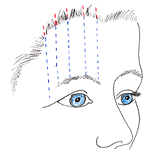|
The technique
These are my aims and this is how I have tried to achieve it.
 Incisions: About 3-4 vertical ,lines are drawn on the forehead to demarcate areas of the brow that need elevation. Two incisions are made in the hairline vertically above each other. The incisions are placed between the hair roots to make the scars inconspicuous.
Incisions: About 3-4 vertical ,lines are drawn on the forehead to demarcate areas of the brow that need elevation. Two incisions are made in the hairline vertically above each other. The incisions are placed between the hair roots to make the scars inconspicuous.
Lifting of the skin: use a 2 mm lipo-suction needle to dissect the skin free from the muscle through all the incisions. This also ensures a channel for the spinal needle to protrude through the incision.
I believe that this breaks the fibres that are associated with transverse wrinkles on the forehead, and also promotes shrinking of the forehead skin. It may also help to hold the forehead skin in an elevated position.
Inserting the needle:
A spinal needle size 18 is long enough for the average forehead. Pierce the eyebrow and go below the substance of the eyebrow with the spinal needle and push the needle through the anterior incision. Prolene 5/0 thread or equivalent is then threaded into the needle and pulled through so that only about 10 cms is left out with the Prolene needle. Withdraw the Spinal needle until the tip is about 2-3mm from the skin surface, and then change course superficially to grab the eyebrow tissue itself, and aim for the incision. Once the needle is through the incision, the Prolene suture can be extracted from the lumen of the needle. This means that the Prolene suture goes down through the one incision down to the brow and then up again to the second incision. The needle is easily passed through so that both threads are positioned in one incision. I have tried to catch the galea when passing the needle across. The loop of Prolene can now be tightened and the brow elevated as required and then the knot is tied.
I use a double throw for the first part of the knot. Exactly how much to tighten the knot requires some judgement. We have to bear in mind the mobility of the scalp.
When a person is upright, then the natural position of the scalp can be pulled backwards but cannot really be brought forward. When lying down, the reverse holds true: the scalp can be brought forwards but cannot be pulled backwards.
In some cases, we only need only to prevent the brow from descending because when the patient is lying down the brows are in a pretty ideal position. A slight exaggeration of about 2-3 mm is necessary. Very often one will notice that if there is a correct amount of skin on the upper eyelid, then the eyelid will be pulled open by this manoeuvre. I put some hydrating gel into the eyes at the time of the operation and for the first few days.
The procedure is repeated in three or four places and if necessary, where there are deep crows feet or smile lines, then an added set of suspensory sutures may be put into the lateral part of the orbicularis muscle itself very similar to the sutures described by Horibe - but without any incision of the skin. I have also tried to lighten frown lines by using oblique sutures to pull the brows apart and upwards. The can be effective in some people but may cause discomfort in others when they attempt to frown.
The small skin incisions do not require suturing. The brow is taped to try and reduce the amount of swelling and bruising. I conclude the operation by inserting two butterfly needles over each supra-orbital nerve so that a solution of Marcaine can be infiltrated if the patient has post-operative headache .
|